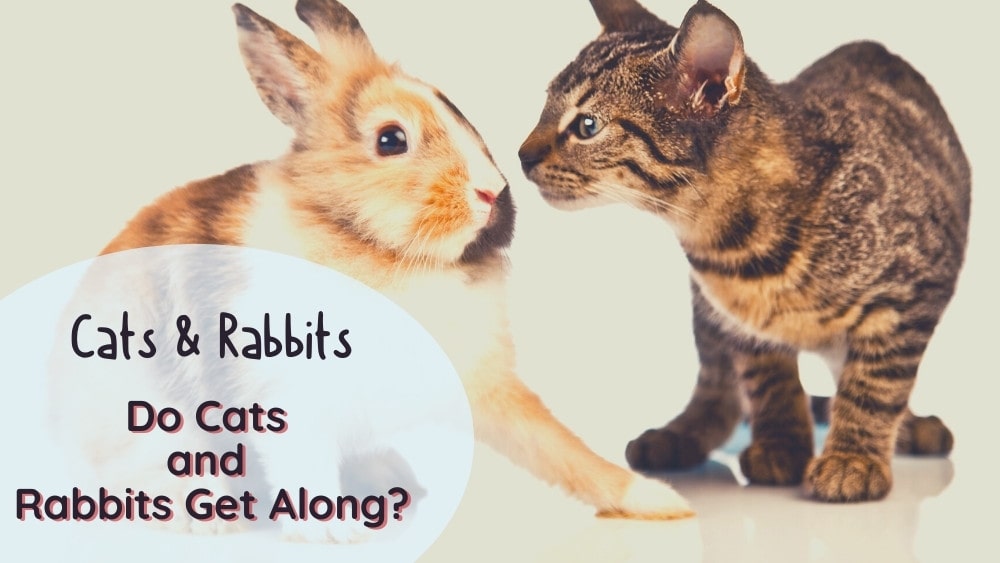Both cats and rabbits are popular pets, and it’s not uncommon to see them living in the same household. This leaves many potential owners wondering: ‘do bunnies and cats get along?’ Although cats and rabbits aren’t natural friends, they can live harmoniously.
In my experience, how well they get along depends on the individual cat and rabbit. There are many factors involved. There are steps you can take to help the introductions run as smoothly as possible.
This article will cover everything you need to know about bunnies and cats being friends. We’ll discuss the risks and how you can introduce your furbabies to help them bond.
Do Bunnies and Cats Get Along?
Rabbits and cats can get along very well in some circumstances. Whether they become friends depends on their personalities, among other factors. They’re more likely to bond if you introduce them at a young age. Slow introductions are essential to keep both animals safe.
Understanding The Basics
While cats and rabbits can live together successfully, there are some important things to remember.
The more you know about the dynamics involved, the better prepared you will be to set the relationship up for success.
Predators and Prey
There’s no escaping from the fact that cats are predators and rabbits are prey animals. However, these instincts may be lessened in a domestic setting because your pets don’t need them to survive.
Before introducing a cat and a rabbit, think about how much of these instincts they display. For example, consider whether your cat has a high prey drive and often chases smaller animals.
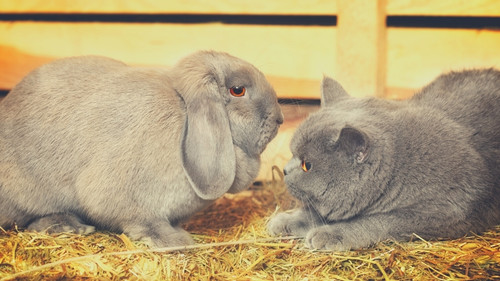
Pay particular attention to their behavior inside the home. Most cats will display some hunting behavior if allowed outside but tend to be more relaxed indoors.
If you have a particularly nervous rabbit that isn’t very sociable, introducing a cat into your home may not be the best idea.
Cats are far more likely to chase rabbits if they run away and try to hide. However, if your rabbit is quite confident and sociable, they’re more likely to get along.
Social Behaviour
Rabbits are highly social animals. In the wild, they would live in a group called a colony. This means they’re more inclined to make friends, even with another species, because they’re happier living with other animals.
On the other hand, cats can be pretty solitary creatures, so they are less naturally driven to bond with another animal.
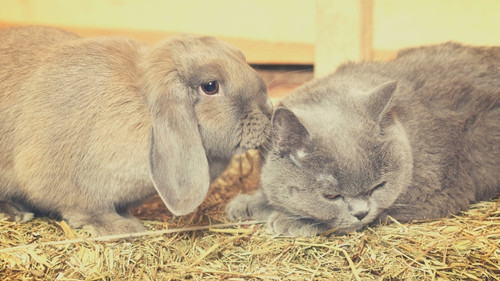
Within a rabbit’s wild colony, there would be a social hierarchy. This means that rabbits are likely to try to establish dominance with other animals in the home.
They’re also quite territorial. Therefore, they might try to be dominant and boss the cat around, especially if your cat is timid. This behavior will usually settle down once they realize the cat isn’t a threat.
Size and Breed
Size is one of the most important factors when introducing a bunny and a cat. If your bunny is much smaller than the cat, the cat is far more likely to see it as prey.
Similarly, if you have a large breed rabbit that is bigger than your cat, the bunny may be more aggressive in trying to establish dominance.
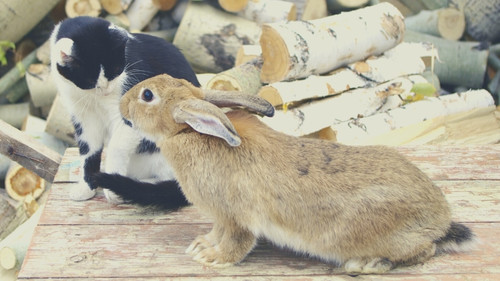
If one pet is bigger than the other, they may accidentally harm each other even if they don’t have a disagreement.
For the best results, pair a cat and a rabbit of a similar size. This reduces the risks and helps them to see each other as ‘equals.’ It’s best to introduce them when they’re both babies, which we’ll discuss later.
Different Personalities
Just like humans, rabbits and cats have their own personalities. Some rabbits I’ve worked with have been outgoing and confident, while others have been shy and reserved.
Likewise, when I worked in a cattery, I found the cat’s personalities varied greatly! Whether your cat and bunny’s personalities mesh well together is one of the most important determining factors for whether they get along.
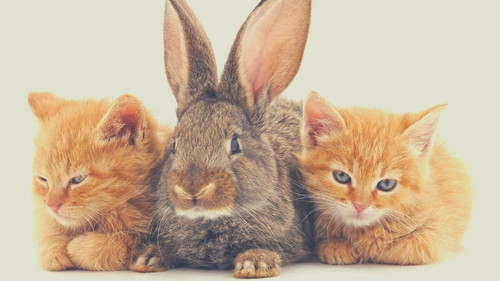
For example, if one or both animals tend to display aggressive or dominant behavior, they’re unlikely to coexist peacefully.
If your bunny is very territorial and often tries to ‘protect’ their living area, it’s doubtful they’ll accept another species into their space.
In contrast, if both animals are quite calm and sociable, there’s a great chance they’ll get on!
Weighing Up The Risks
At the end of the day, rabbits are prey, and cats are carnivores. So, there are always going to be some risks. Let’s take a closer look.
Do Cats Attack Rabbits?
Cats have a natural prey drive. Some cats will see rabbits as prey and attack them. However, others won’t be aggressive and may be very gentle.
If a cat typically chases small animals like birds and squirrels outdoors (or is very tense watching them from the window), they’re more likely to attack a rabbit.
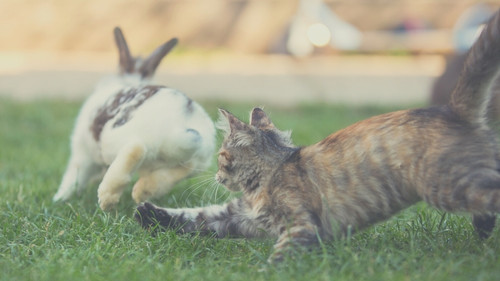
Cats tend to chase animals that are much smaller than them. Therefore, they’re more likely to see a smaller rabbit as prey. If a rabbit is close to the same size as the cat, they’re unlikely to attack even if they have a high prey drive.
Cats have sharp claws and teeth, so they can do quite a bit of damage if they choose to. This might leave you wondering: “will a cat kill a rabbit?” The answer is yes, a cat could kill a rabbit.
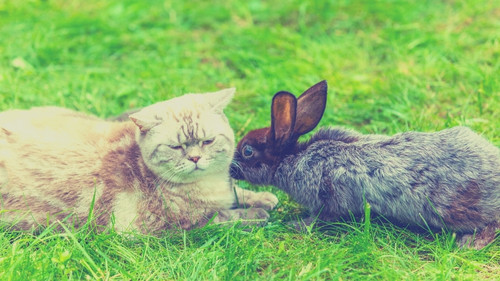
This is far more likely if the rabbit is smaller than them and can’t defend itself. This depends on the individual cat and rabbit, but it is possible.
Taking steps to introduce them to each other properly increases safety and reduces the risk of an attack.
Do Rabbits Attack Cats?
You might be surprised to hear that rabbits can attack cats. This might sound funny, but with their strong teeth and powerful back legs, they can actually do quite a bit of damage!
If they’re particularly territorial, they may lash out if the cat comes into their space.
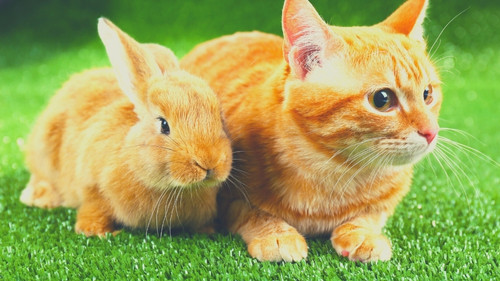
Rabbits may also attack out of fear if they feel the cat is a threat. Thankfully, in most situations, bunnies are far more likely to threaten to attack than actually follow through with a full-blown fight.
The steps below will help to keep introductions as safe as possible for both rabbit and cat.
How to Introduce Cats to Rabbits
Introducing your cat and rabbit slowly and carefully is essential to keep them safe. The process is similar to bonding two rabbits. Below are steps to guide you.
Choosing a Friend
If you already have a cat or bunny and are going to bring a new friend home for them, do plenty of research.
We’ve already established that choosing a friend who is roughly the same size is crucial.
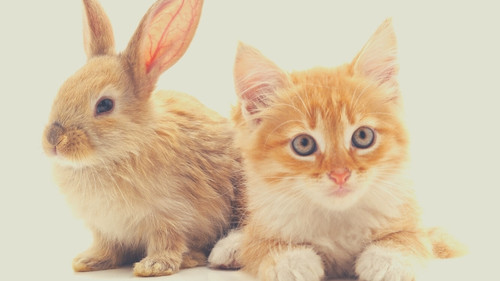
If you are adopting a rabbit or cat, the rescue center should be able to give you a good idea of which animal in their care could make a good companion for your existing pet.
They will be able to tell you about the animal’s personality and allow you to meet them before making a choice. This lets you to see which bunny or cat you feel will best get along with your current pet.
If you’re bringing home a cat or rabbit from a breeder, ensure they’re reputable, and that health checks are done beforehand.
A good breeder should be able to give you some insight into an animal’s personality traits to help you make the best choice.
If you can, it’s best to introduce a cat and rabbit when they’re both babies. At this age, they’re more open and curious. They’re more likely to bond with another species and are generally less likely to be aggressive.
If two animals grow up together, they usually have a much closer bond. If you’re bringing home a kitten and a kit (a baby rabbit), choose breeds that will be a similar size as adults.
Safety Measures
Before you introduce your two pets, it’s best to get their health checked by a vet. Ensure all of their vaccinations and parasite treatments are up to date.
This prevents them from passing on illnesses to one another. Spaying or neutering your pets can help to reduce aggressive or territorial behavior.
Give both cat and rabbit a nail trim so they don’t hurt each other accidentally. This also reduces the risk of serious injury if they squabble.
Having some safety equipment on hand is worthwhile so you can break up a fight if the worst should happen. A broom or dustpan can help you to stop a fight without getting yourself hurt.
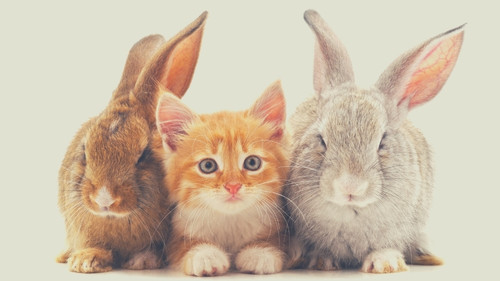
I’d advise having thick gloves on hand so you can intervene further if needed. A spray bottle to squirt some water can be handy. It sounds a bit strange, but sometimes the shock of the water can be enough to diffuse a tense situation.
When you’re first introducing a cat and a rabbit, I recommend having some pet first aid equipment on hand. For example, you could have some bandages, gauze, and blood-stopping powder ready.
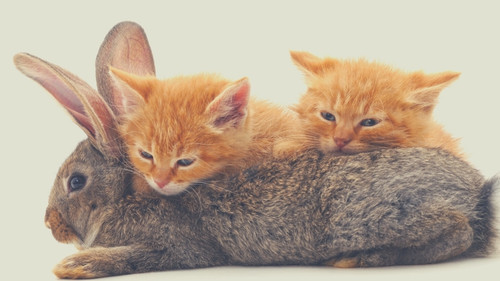
It’s not nice to think about, but if the worst happens, you’re prepared to treat any wounds.
Starting With a Barrier
When you first introduce them, keep your rabbit safely in an enclosure. Ensure the enclosure is secure and has a roof to prevent the cat from jumping in!
A barrier between them keeps them both safe and allows them to get used to the smell and sight of one another.
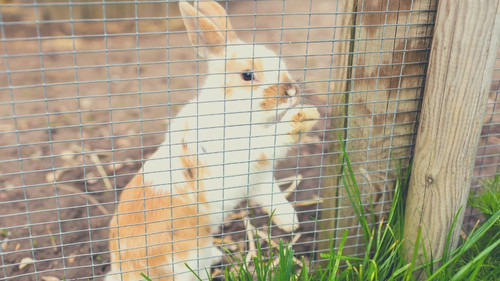
Provide shelter on both sides of the barrier so both rabbit and cat can hide if they feel overwhelmed or scared. It’s crucial you supervise them at all times, even though the barrier is in place.
I recommend having your rabbit in a separate room with an enclosure inside so you can let the cat into the room for short periods.
This way, when either animal gets stressed, you can separate them and let them cool off. This setup allows you to go into the room and let the rabbit out for floor time and interaction with you while keeping the cat safely in another room.
The enclosure should give your rabbit plenty of room, as this process will likely take weeks or months.
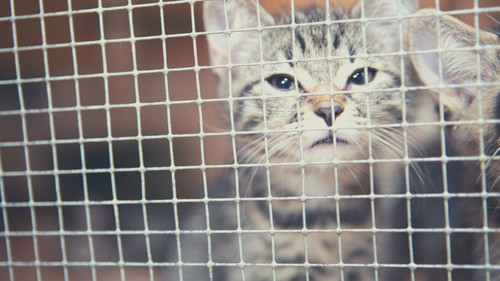
Take it slowly, and don’t be tempted to rush. During this time and moving forward, ensure you give both animals equal attention and time with you. This prevents jealousy and discourages competitiveness.
Increase the amount of time they spend in the same room each day. Once they’re spending a considerable amount of time in each other’s presence and they both seem calm, you can move on to the next stage.
Neutral Territory
To prepare for face-to-face introductions, choose a neutral place inside your home. Ideally, somewhere neither animal has been before.
A neutral area prevents territorial behavior. Neither animal feels they ‘own’ the space, so they don’t need to defend it or guard resources.
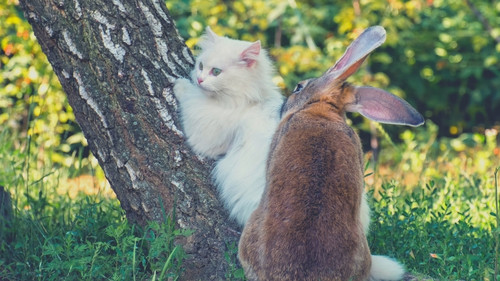
I would provide at least two shelters in the neutral area so that both animals can hide if they want to. You might also want to put out some toys as distractions.
I recommend eliminating things your cat can climb on in this space. If your cat is up higher than the rabbit, your bunny may see this as a threat.
Face-to-Face Introductions
Now you’re ready to introduce your cat and bunny without the barrier. Bring them both into the neutral space.
Ideally, you should place them at opposite sides of the neutral area so they can approach one another in their own time. Have your safety equipment on hand and supervise them carefully. Be ready to intervene if needed.
For the first meeting, start with five or 10 minutes. You can gradually increase their time together each day.
Monitor their body language and behavior for signs of potential trouble. Once they seem relaxed and spend a decent amount of time together, you’ve successfully bonded your furbabies!
Always Supervise
Even once you’ve completed the bonding process, it’s crucial that your rabbit and cat are only together when you’re supervising.
Animals are unpredictable, and as we’ve mentioned, rabbits are prey. Keep them separate for safety when you’re asleep or out of the home.
Coexisting Versus Being Friends
If you’ve tried to bond your pets and it hasn’t been successful, try not to panic. It can be distressing when two household members don’t get along, but they can still live together.
Instead of bonding, the goal should be coexisting and tolerating each other.
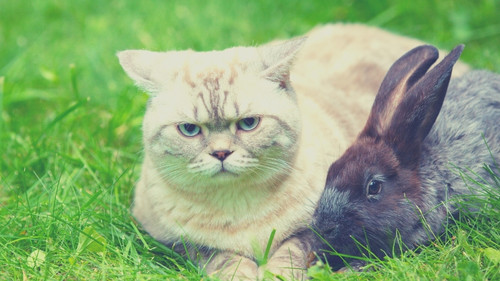
If there’s been no aggression, you might find it’s safe for both bunny and cat to be in the same room under your supervision.
They may avoid each other and choose not to interact, which is completely fine as long as neither animal is overly stressed.
If there has been aggression between your cat and rabbit, you’ll need to keep your rabbit in a room where your cat isn’t allowed to enter. You can keep your rabbit’s enclosure in this room and let them out to interact with you and play.
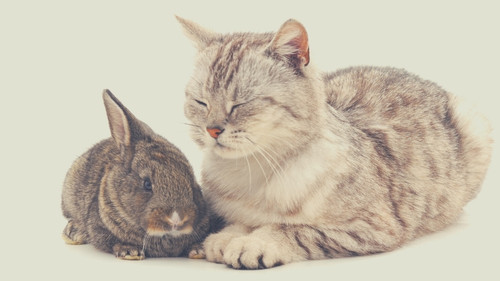
This ensures your bunny can have plenty of room to live happily, as hutches and cages aren’t enough. If this isn’t possible, you must carefully secure your rabbit’s enclosure so your cat can’t get to them.
It’s best to create an extra barrier around their enclosure. This prevents the cat from coming up to the side of the enclosure and stressing out your rabbit.
You can give your bunny more space to explore your home and garden regularly by closing your cat in one room for a short time. Both animals can still have an excellent quality of life and be part of your family.
Conclusion
Although they’re different species, cats and rabbits can be great friends. It’s adorable to see! Since cats are predators and rabbits are prey, they need to be introduced slowly for safety. How well they bond will depend on their personalities. Either way, cats and rabbits can live in the same household when appropriate safety measures are taken.
Did you find this information helpful? Have you owned a cat and a rabbit? We’d love to hear about your experience in the comments.


